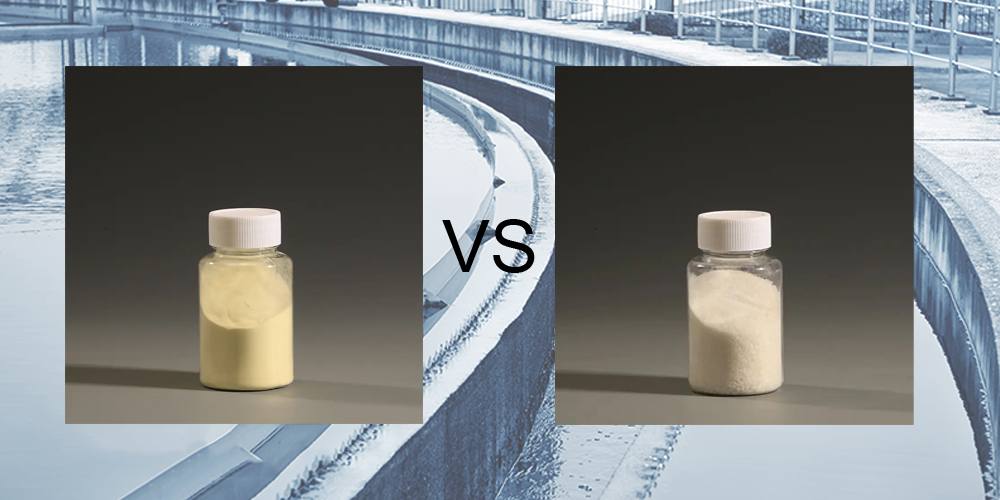एल्युमिनियम क्लोरोहाइड्रेट (एसीएच) और पॉलीएल्युमिनियम क्लोराइड (पीएसी) दो अलग-अलग रासायनिक यौगिक प्रतीत होते हैं जिनका उपयोगजल उपचार में फ्लोक्यूलेंटवास्तव में, ACH, PAC परिवार में सबसे अधिक सांद्रित पदार्थ है, जो ठोस रूपों या स्थिर विलयन रूपों में प्राप्त होने वाली उच्चतम एल्यूमिना मात्रा और क्षारीयता प्रदान करता है। दोनों के विशिष्ट प्रदर्शन थोड़े भिन्न हैं, लेकिन उनके अनुप्रयोग क्षेत्र बहुत भिन्न हैं। यह लेख आपको ACH और PAC की गहन समझ प्रदान करेगा ताकि आप सही उत्पाद चुन सकें।
पॉलीएल्युमिनियम क्लोराइड (PAC) एक उच्च आणविक बहुलक है जिसका सामान्य रासायनिक सूत्र [Al2(OH)nCl6-n]m है। अपने अद्वितीय रासायनिक गुणों के कारण, विभिन्न क्षेत्रों में इसके व्यापक अनुप्रयोग हैं। पॉलीएल्युमिनियम क्लोराइड (PAC) जल उपचार में महत्वपूर्ण भूमिका निभाता है, और स्कंदन प्रक्रियाओं के माध्यम से निलंबित ठोस पदार्थों, कोलाइडल पदार्थों और अघुलनशील कार्बनिक पदार्थों को प्रभावी ढंग से हटाता है। कणों को निष्क्रिय करके, PAC एकत्रीकरण को प्रोत्साहित करता है, जिससे उन्हें जल से निकालना आसान हो जाता है। PAC, जिसका अक्सर PAM जैसे अन्य रसायनों के साथ उपयोग किया जाता है, जल की गुणवत्ता में सुधार करता है, गंदलापन कम करता है और उद्योग मानकों को पूरा करता है।
कागज़ निर्माण क्षेत्र में, PAC एक लागत-प्रभावी फ्लोक्यूलेंट और अवक्षेपक के रूप में कार्य करता है, जो सीवेज उपचार और रोसिन-न्यूट्रल साइज़िंग में सुधार करता है। यह साइज़िंग प्रभाव को बढ़ाता है, कपड़े और सिस्टम के संदूषण को रोकता है।
PAC का उपयोग खनन उद्योग तक फैला हुआ है, जो अयस्क धुलाई और खनिज पृथक्करण में सहायता करता है। यह गैंग से पानी को अलग करता है, जिससे पुन: उपयोग में आसानी होती है, और कीचड़ का निर्जलीकरण होता है।
पेट्रोलियम निष्कर्षण और शोधन में, PAC अपशिष्ट जल से अशुद्धियों, अघुलनशील कार्बनिक पदार्थों और धातुओं को हटाता है। यह तेल की बूंदों को डीमल्सीफाई और हटाता है, कुओं के छिद्रों को स्थिर करता है और तेल ड्रिलिंग के दौरान होने वाली क्षति को रोकता है।
कपड़ा छपाई और रंगाई को पीएसी की बड़ी मात्रा और उच्च कार्बनिक प्रदूषक सामग्री वाले अपशिष्ट जल के उपचार की क्षमता से लाभ होता है। पीएसी फिटकरी के फूलों के मज़बूत और तेज़ जमाव को बढ़ावा देता है, जिससे उपचार के उल्लेखनीय परिणाम प्राप्त होते हैं।
ACH, एल्युमिनियम क्लोरोहाइड्रेट, जिसका आण्विक सूत्र Al2(OH)5Cl·2H2O है, एक अकार्बनिक बहुलक यौगिक है जो पॉलीएल्युमिनियम क्लोराइड की तुलना में उच्च क्षारीकरण स्तर प्रदर्शित करता है और केवल एल्युमिनियम हाइड्रॉक्साइड से पीछे है। यह हाइड्रॉक्सिल समूहों के माध्यम से ब्रिज पोलीमराइजेशन से गुजरता है, जिसके परिणामस्वरूप अणु में सबसे अधिक संख्या में हाइड्रॉक्सिल समूह होते हैं।
जल उपचार और दैनिक-रासायनिक ग्रेड (कॉस्मेटिक ग्रेड) में उपलब्ध, ACH पाउडर (ठोस) और तरल (घोल) रूपों में आता है, जिसमें ठोस एक सफेद पाउडर होता है और घोल एक रंगहीन पारदर्शी तरल होता है।
अघुलनशील पदार्थ और Fe सामग्री कम है, इसलिए इसका उपयोग दैनिक रासायनिक क्षेत्रों में किया जा सकता है।
ACH के विविध अनुप्रयोग हैं। यह दवाइयों और विशिष्ट सौंदर्य प्रसाधनों के लिए कच्चे माल के रूप में काम करता है, विशेष रूप से प्राथमिक एंटीपर्सपिरेंट घटक के रूप में, जो अपनी प्रभावकारिता, कम जलन और सुरक्षा के लिए जाना जाता है। इसके अलावा, ACH महंगा है और इसलिए पेयजल और औद्योगिक अपशिष्ट जल उपचार में फ्लोक्यूलेंट के रूप में इसका उपयोग शायद ही कभी किया जाता है। ACH पारंपरिक धातु लवणों और निम्न-बेसिन पॉलीएल्यूमीनियम क्लोराइड की तुलना में व्यापक pH स्पेक्ट्रम पर प्रभावी संघनन भी प्रदर्शित करता है।
पोस्ट करने का समय: 28 अगस्त 2024


